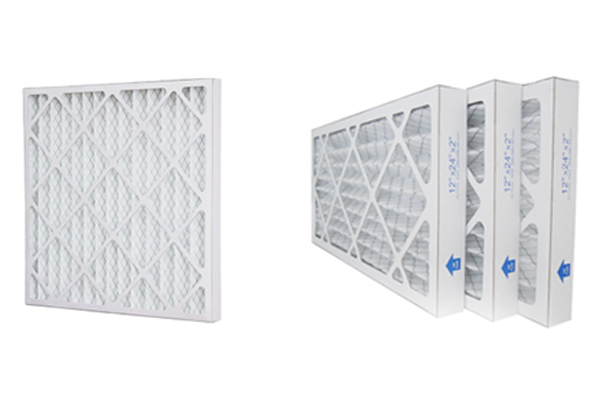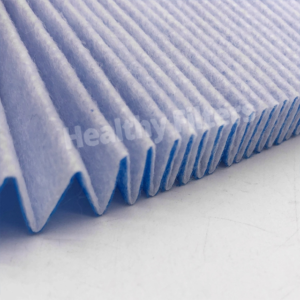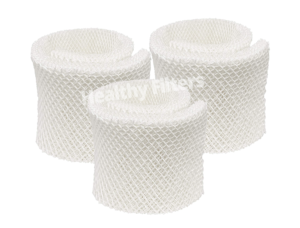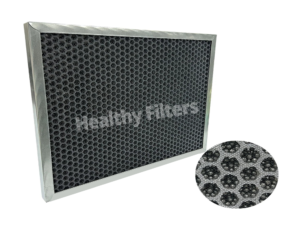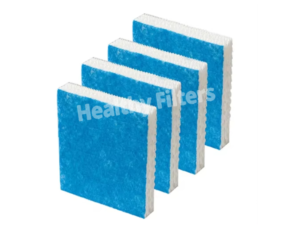MERV 8/11/13/14 Paper Frame Filter is a medium-efficiency air filtration device based on the ASHRAE 52.2 standard classification. It adopts multi-layer composite filter material and rigid cardboard frame design, and is specially designed to provide particle classification interception solutions for commercial buildings, industrial facilities and clean environments. With its lightweight, cost-effective and easy-to-replace characteristics, it has become the mainstream choice for balancing filtration efficiency, energy consumption and maintenance costs.
Core classification and filtration performance
MERV 8 (medium efficiency)
Filtration efficiency: can capture 3-10μm particles (such as pollen, dust, mold spores), efficiency ≥70% (for ASHRAE standard test dust).
Application scenarios: Central air conditioning systems in commercial office buildings, schools, and retail stores, protecting surface coolers and fans.
MERV 11 (Medium and High Efficiency)
Filtration efficiency: intercepts 1-3μm particles (such as fine dust, automobile exhaust particles), with an efficiency of ≥85%, and has preliminary control capabilities for PM2.5.
Application scenarios: pre-filtration of ventilation systems in hospital outpatient areas, hotels, and food processing plants.
MERV 13 (Quasi-High Efficiency)
Filtration efficiency: captures 0.3-1μm particles (such as bacteria, smoke, and virus attachment carriers), with an efficiency of ≥90%, close to the HEPA standard (H13 grade filtration lower limit).
Application scenarios: front-end air purification in laboratories, electronic workshops, and ICU wards.
MERV 14 (High Efficiency)
Filtration efficiency: for ultrafine particles of 0.3-0.5μm (such as viruses and some aerosols), the efficiency is ≥95%, meeting the ISO 16890 ePM1 classification requirements.
Application scenarios: clean rooms in pharmaceutical factories, high-end data centers, and biosafety laboratories.
Core advantages of paper frame structure
Lightweight and environmental protection
The frame is made of high-density waterproof paperboard, which is 30%-50% lighter than metal/plastic frames, reducing transportation and installation costs; paper materials are recyclable and degradable, meeting the requirements of green building (LEED) certification.
Multi-layer composite filter material design
Polyester fiber and glass fiber are gradiently laminated, and the outer coarse and inner fine structure takes into account both dust holding capacity and low resistance (initial pressure difference 40-120Pa). MERV 13/14 models often add an electrostatic electret layer to enhance submicron particle adsorption.
Moisture resistance and durability
The paper frame is treated with wax or resin coating to withstand humidity ≤80% environment to avoid deformation due to moisture; antibacterial agents are added to the filter material to inhibit microbial growth and extend service life (typical replacement cycle 6-12 months).
Compatibility and economy
Standardized sizes (such as 610mm×610mm, 592mm×592mm) are suitable for most air-conditioning units; the unit price is 20%-40% lower than that of metal frame filters, suitable for large-scale procurement.
Typical application areas
Healthcare: hospital operating room exhaust system, PCR laboratory pre-filtration, reduce the risk of cross infection.
Electronic manufacturing: semiconductor workshop, display production line, intercept particles to protect precision instruments.
Educational institutions: classroom fresh air system, reduce PM2.5 and allergens, improve indoor air quality.
Public transportation: subway station, airport terminal ventilation system, control the concentration of inhalable particles.
Selection and maintenance recommendations
Selection criteria
Pollution type:
MERV 8: ordinary dust, pollen environment (such as shopping malls, warehouses).
MERV 11-13: fine dust, microbial control requirements (such as food factories, hospitals).
MERV 14: ultra-fine particle sensitive scenes (such as chip factories, biological laboratories).
Air volume matching: select the number and thickness of filters according to the rated air volume of the equipment (commonly 25-100mm) to avoid the loss of efficiency due to over-speed operation.
Maintenance optimization
Pressure difference monitoring: Install a pressure difference gauge. The replacement threshold for MERV 8/11 filters is 250-300Pa, and MERV 13/14 recommends 200-250Pa.
Pre-protection: Use a primary filter (MERV 4-6) to intercept large particles and extend the life of the main filter by 30%-50%.
Replacement cycle: Low-pollution environments (such as offices) can be replaced every 12 months; high dust/high humidity scenarios need to be shortened to 6-8 months.
MERV 8/11/13/14 paper frame filters provide flexible and economical air purification solutions for scenarios with different cleanliness requirements through graded filtration and innovative paper-based design, helping to achieve the synergistic goals of healthy environment, equipment protection and sustainable operation.

